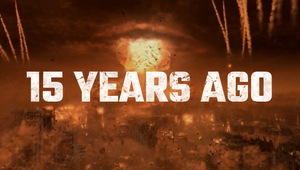
5 Entertaining Advertising Activations That Made an Impact in 2018

At a time where entertainment has never been more predominating in our lives, brands need to change their traditional comms approaches to attract audiences that are more demanding. To do so, what could be more inspiring than brands from the entertainment industry?
Here, digital agency Biborg takes us on a world tour of the latest top-in-class activations and campaigns from the entertainment sector.
1. Fortnite’s epic alternate reality Game for its Season 5 release
Fortnite is a competitive online game developed by Epic Games, well known for its gaming mode based on the concept of Battle Royale (100 people on a map, the winner is the last man standing at the end of the game). While the game enjoys around 40 million players each month, Epic Games planned to grow the hype around its Season 5 release with a huge alternate reality game (ARG).
It consisted of hiding clues both in-game and in the real world to let gamers find out the new season’s theme: a world filled with spatio-temporal flaws, which create direct consequences on the gameplay.
In game, players had to find audio files hidden in different objects, redirecting to coordinates from the game’s map. These audio files teased the new locations that will be available in Season 5. In real life, a big 'Durr Burger' was found in a Californian desert, surrounded by 'fake' agents with their police cars (inspired by the game). The agents gave cards to all curious visitors with a phone number to call. When calling, players could hear a sound revealing a hidden message (decodable through spectrogram) with new coordinates on the map. A few days later, a total of seven llamas looking just like the Supply Llamas from the game were found in Europe including London, Paris, Warsaw and Barcelona.
Basically, Epic Games blurred the lines between the real world and the game.
Positive points
Even on a smaller scale (not every brand can make an ARG that big), this kind of activation is definitely inviting people to live an immersive and memorable experience. It is a good retention booster and also a good way to generate awareness as it has a strong PR potential.
Negative points
This kind of activation may only work for brands, products and services that already have a huge and very engaged fan base. Moreover, if the fans don’t play the game or don’t succeed at understanding the meaning of a clue, the whole activation could fizzle out. It needs to be highly prepared upstream.
To go further...
We would have created an iframe where all Fortnite fans could have gathered their insights about the clues and tried to solve some of them in a collaborative way instead of letting them do it through social media and Reddit. On the other hand, this would have given a more 'marketing' flavour to the activation, which most gamers reject.
2. Mission: Impossible - Fallout and its impossible screening
For Mission: Impossible - Fallout's release, Paramount Pictures organised a unrivalled outdoor screening on 1st August. Around 2000 fans were invited to climb 604 meters above the Lysefjord Lake (Norway) leading to the top of the Preikestolen Cliff. After a four hours of intense physical effort, all these fans could watch the movie with some scenes shot at the exact same place. While Tom Cruise, the lead actor in the movie, was not there, he actively took part in the 'impossible' screening promotion on social media.
Positive points
The whole idea is totally in line with the movie itself and has a huge potential in terms of PR.
Negative points
This kind of activation definitely needed some material to reveal it to the mainstream audience, otherwise its coverage rate would be very low. Indeed, except some images on social networks, there was no brand content to support the screening and give it big exposure on social networks.
To go further...
We would have filmed the ascension of the 2000 climbers live to push this content on social networks (Instagram, Facebook) and Twitch.
3. Detroit: Become Human is blurring the lines between robots and humans
For Detroit: Become Human, PlayStation blurred the lines between robot and human throughout the pre-launch and launch campaigns from 2017 to May 2018. Indeed, this narrative action game takes place in a 2038 Detroit, where highly advanced androids are serving mankind. At every gaming event (Paris Games Week, Gamescom, E3,...), PlayStation installed a group of robot-like people displayed in a showcase in its booths. To keep aid immersion, the 'robots' were described as products that visitors could buy.
Positive points
The idea of expanding the game fantasy to the real world which directly immerses the audience in the universe. The high quality of the activation instantly gave it a social and PR potential (some attendees were really confused, they did not know if they were robots or actors…).
Negative points
Only those who were attending these events (mostly B2B ones) could enjoy this performance: the impact was less important than if it was showed to a mainstream audience during open and mainstream events.
To go further...
We would have used AR technology on Facebook or Snapchat to allow every user to make an Android appear in the same room as them and interact with him/her via their smartphone.
4. God of War brought Warsaw walls to life
On the occasion of God Of War's launch in April 2018, PlayStation installed augmented street art in Warsaw's streets. During the day, people could admire the colossal street art. The most surprising aspect of the activation however was happening during the night… When the sun was going down, you could see a huge projection map augmenting the street art for a stunning performance.
Positive points
First, using street art as an advertising medium is totally in line with today’s urban and youth culture. The idea of augmenting this street art is also very effective - it surprises the audience at night and allows them to live a real experience and not just be exposed to advertising.
Negative points
It seems the location was not the most strategic one and the activation was only made once in one place; only a few bystanders could have enjoyed the performance. The coverage rate was probably not very high.
To go further...
We would have turned this map into an interactive one: depending on the amount of people standing in front of the street art (on the bridge for instance), the projection epicness would evolve and grow proportionally.
5. BONUS: Greenpeace and its BBQ g-funk video clip
Even if brands from the entertainment industry are paving the way for playful and entertaining advertising approaches, some brands outside the industry are bringing a lot of creativity to the table.
For summer, Greenpeace France made a little buzz with this homemade g-funk song and video clip. Greenpeace imitated the style of iconic rappers (Notorious B.I.G, B-Real, Snoop Dogg and Billy Lawrence) to raise awareness about the overconsumption of meat and expose its consequences on the planet.
Positive points
While videos are probably the most appreciated and watched format by young people, this musical video clip is definitely a good strategic choice. Moreover, the creation of the content has a great quality; it fits the youth expectations in terms of musicality and entertainment.
Negative points
For an organisation like Greenpeace which really needs to engage their audience and make them take action, a video on YouTube might not be enough. Once they watched the video, people probably did not go on the BBQSONG website to make donations.
To go further...
We would have turned this video into a gamified online karaoke (on a digital website or iframe), inviting people to record themselves with friends as they try to sing the lyrics perfectly. For each perfect recording shared on social media with a donation promise, Greenpeace itself (or a partner) would multiply the amount by two.















